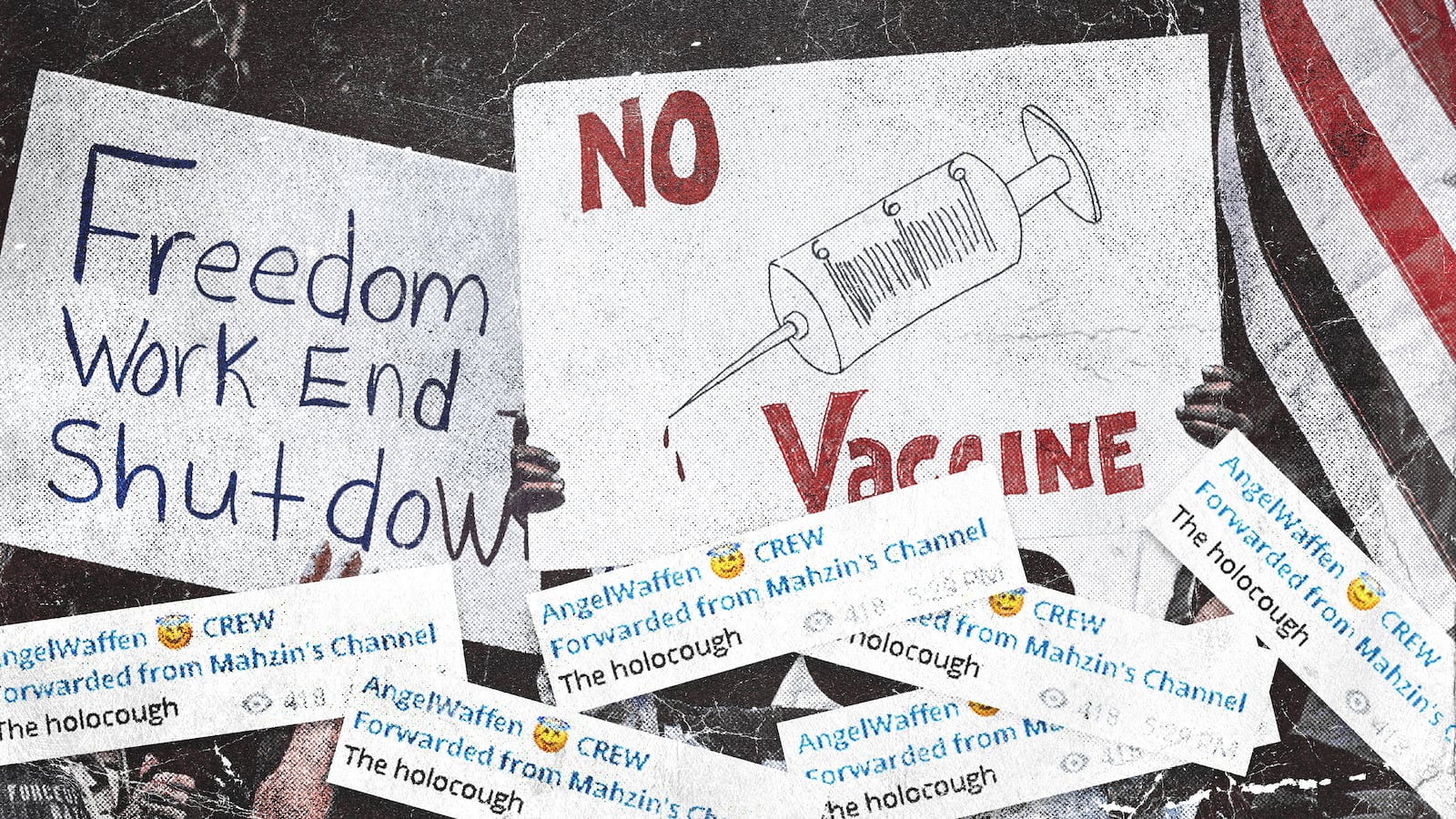In May, conspiracy theory and hate speech monitoring groups started flagging the spread of a disturbing anti-Semitic meme: a stylized picture of the novel coronavirus on a tie-dye-like background framed with text reading, “COVID-19. If you have the bug, give a hug. Spread the flu to every Jew. Holocough.”
A report by the Community Security Trust, a British group that works to stop the spread of anti-Semitism, cast the meme as the apex of far-right chatter “about getting infected, either deliberately or accidentally, and then going to synagogues and other Jewish buildings to try to infect as many Jewish people as possible.”
The meme soon largely fell out of the public eye. But the term holocough spread, and not just among twisted circles advocating the anti-Semitic weaponization of the virus.
According to several digital hate speech monitoring groups canvassed by The Daily Beast, the term has been used as a tagline for a slew of conspiracy theories in recent months. Among them are deluded ideas that deny the existence or extent of the horrific COVID-19 pandemic, accept the pandemic but believe it’s a Jewish invention created for profit or population control, or suggest pandemic control measures are a prelude to Holocaust-like mass internments by the “deep state.”
The meme has also cropped up in shitposts with no clear ideology or goal beyond provocation.
The story of how and why this trope caught fire and spread across many seemingly distinct and even opposed strains of conspiracy and hate is representative of how ideas flow through and across far-right factions in modern America, experts said. Understanding those dynamics is especially vital right now, as open hate and conspiracy theories are enjoying remarkable visibility in mainstream politics. Among recent examples, the Republican National Convention had to boot a speaker after The Daily Beast revealed she’d recently retweeted a particularly virulent anti-Semitic QAnon thread. Days earlier, President Trump himself effectively embraced QAnon at the White House.
Grasping the way deranged totems like this one morph and spread is also important because America is still deep in the throes of the historic COVID-19 pandemic. As public health scholar Lawrence Gostin told The Daily Beast, conspiracies that sow doubt about the nature of and responses to the coronavirus are “probably the single greatest threats to public health” today.
Because the social mediascape is vast, fractured, and at times opaque, Aryeh Tuchman of the Anti-Defamation League cautioned it’s difficult to track the precise origin of terms like holocough. But Rick Eaton, a digital hate researcher at the Simon Wiesenthal Center, told The Daily Beast that the earliest usage he’s been able to document during the pandemic came from a Telegram post on March 11. (Telegram did not respond to a request for comment for this story.)
It read, simply, “the holocough.”
By that time, anti-Semitic pandemic conspiracy theories and hate had already been burbling up online for months. Conspiracy theories typically form and spread in times of confusion and upheaval, as people search for clear and easy answers, and for individuals to blame. They often pile on to established scapegoats—like Jewish populations, who have been wrongly blamed for pandemics since at least the 14th century Black Death, and falsely accused of manipulating literally every major global event to benefit themselves and hurt others.
Someone apparently saw holocough, liked it, and forwarded it to other Telegram groups, until it seemingly caught the eye of notorious shitposter Milo Yiannopoulos, and he included it in a March 16 poll on his Telegram channel on what he and others should call the virus, pitting it against Chinese flu, kung flu, Wuhan wheezer, boomer doomer, and ching chong chinky-wong ping lo wang pao sweet & sour sickness. (Yiannopoulos did not respond to a request for comment.) That likely put it on the radar of people advocating many different strands of conspiracy theory who all cross over onto each other’s forums and lap up content from major (or once-major) figures like Yiannopoulos.
But hate researchers believe the first person to really pick the term up and run with it was a 30-year-old amateur musician from central Massachusetts who has created several prominent memes used by the esoteric neo-Nazi group Feuerkrieg Division to honor racist killers and advocate for a race war. He allegedly created and posted the “give a hug” meme on March 31. This individual has since scrubbed most of his social media accounts; The Daily Beast attempted to contact him but was unable to reach him as of publication. We are not listing the creator’s pseudonym, nor the real name some researchers believe to be behind it, to avoid giving him and his wider portfolio of far-right propaganda undue attention.
Once it was in the ether, the meme proceeded to take off in neo-Nazi groups already urging followers to cough on synagogues, and to lick items in Kosher aisles.
As Eaton notes, neo-Nazis and other conspiracy and hate groups do not put a premium on consistency. They might deny the Holocaust ever happened, yet allow people in their groups who say it did, and that it just didn’t kill enough Jews, with no debate—and may even adopt that language when it’s convenient. Conspiracy theorists also tend to consume each other’s ideas, mixing and matching them, tossing out bits of them to fit their views. This tendency is especially common among QAnon types. So even though the Massachusetts meme-maker appears to have helped establish holocough as a call to weaponize a real pandemic against Jews, his meme’s sheer visibility invited inconsistent, and chaotic, appropriation.
As suspicions of masking grew in the U.S. this spring, Eaton says virus denial theories, including many rooted in fears of plots to use pandemic control measures to erode freedoms and abet New World Order tyranny, gained traction online—and appropriated the popular holocough tag. As these ideas spread on larger platforms, people saw the phrase, likely found it simply amusing or provocative, and appropriated it for non-ideological posts meant to express amorphous frustration and sow indiscriminate outrage.
The wishy-washy nature of the appropriation of tropes among conspiracy theorists makes experts doubt that that the spread of the holocough tagline represents a marked increase in anti-Semitic beliefs or actions. But just because people use terms like this sporadically and indiscriminately doesn’t mean they don’t pose real threats.
Rabbi Abraham Cooper of the Simon Wiesenthal Center points out that every time the term is shared, regardless of context, “it’s a huge victory from a marketing point of view” for all the nastiest hate and conspiracy groups that use it. It also normalizes the cheapening and erosion of the memory of the Holocaust. And, Gostin stressed, it—like all pandemic-related conspiracy theories—spreads mistrust and confusion that ultimately hinder pandemic control efforts.
The groups The Daily Beast consulted for this article largely agree that the best way to prevent this kind of harm is for governments and social media companies to crack down on tags like holocough. But social media platforms have long struggled with hate speech and dangerous conspiracy theories, although Telegram has reportedly taken steps to remove neo-Nazi communities from its platform recently. And with an avid conspiracy theorist in the White House, and fear of potential erosions of the First Amendment palpable on both sides of the aisle, it’s unlikely they’ll get traction on a political solution in America anytime soon.
That means holocough has space to continue spreading and mutating into bizarre new forms. Most of that evolution will likely play out in tiny conspiratorial and hateful communities on niche platforms, experts stressed. But iterations of the term always have the potential to spill out into the mainstream again—and even into the real world.
Indeed, Holly Huffnagle of the American Jewish Committee told The Daily Beast her team has recently found holocough T-shirts, greeting cards, and other paraphernalia for sale online.







